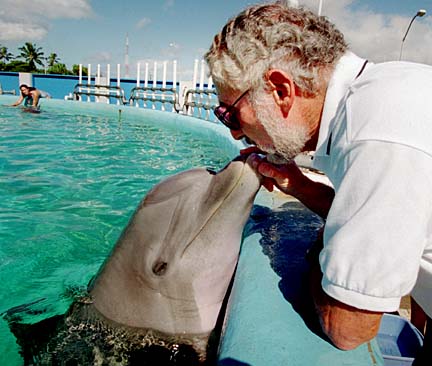Advertisement - Click to support our sponsors.


Dolphin lab Susan Rodenkirchen whirled around, arms at her sides. Akeakamai quickly did the same thing.
mapping out
move to Maui
The renowned Kewalo lab
could be greatly expanded
in Kihei's Maui Nui ParkBy Helen Altonn
Star-BulletinRodenkirchen spinned in the opposite direction, waving her hands. So did Akeakamai.
One lifted her leg; the other her tail.
And so it went, with Akeakamai repeatedly demonstrating that dolphins are natural mimics.
"Their ability to imitate us is incredible," and it's entirely spontaneous, said Louis Herman, watching Akeakamai and volunteer Rodenkirchen at the Kewalo Basin Marine Mammal Laboratory.
Founded by Herman 30 years ago, the lab has grown into an internationally renowned facility for innovative research on dolphin intelligence, sensory perceptions and language.
No scientific knowledge about dolphins could be found in university libraries 30 years ago, according to Adam Pack, assistant lab director and co-founder of The Dolphin Institute with Herman.
"Now, this lab has literally written the book on what the world knows about the mental capabilities of dolphins," he said.
"We're looking forward to decades of further exploration and discovery about these incredible animals."
The marine mammal program will be greatly expanded if plans are approved for a science and education park proposed by the Harry and Jeanette Weinberg Foundation in Kihei, Maui.
The dolphin lab, which has one-fourth of an acre at Kewalo, would occupy five or six acres in the foundation's 29-acre Maui Nui Park.
It would have a one-acre dolphin lagoon, two islands and a waterfall -- "a very stimulating and creative environment to pursue research and education," Herman said. "The dolphins can thrive and rear young."
Maui public hearing tonight
A public hearing on a shoreline permit was scheduled at 6:30 tonight before the Maui Planning Commission at the Kihei Community Center.If the dolphin facility goes to Maui, it no longer will be the Kewalo Basin Marine Mammal Laboratory. It will be The Dolphin Institute.
Herman is president and Pack vice president of the institute, a nonprofit corporation established in 1993 when the laboratory was seeking a new site because of the Kewalo waterfront development. Its mission is to support research, education and conservation of dolphins and whales.
Lab gets $2 million for move
The Hawaii Community Development Corp. gave the laboratory $2 million to relocate, which the University of Hawaii is holding, Herman said.The laboratory has four bottlenosed dolphins -- three females and "one happy male."
The females are Akeakamai, whose Hawaiian name means "lover of wisdom," Elele or "ambassador," and Phoenix, representing the program's redirection. The male is Hiapo, meaning "first-born male."
"We expect the colony to perpetuate itself through births," Pack said, stressing that no dolphins will be taken from the wild.
Herman, a University of Hawaii psychology professor, took over an abandoned Kewalo site to begin dolphin studies in 1970. He began research on humpback whales in 1975, making the first survey by helicopter over Maui waters.
The laboratory has had 33 graduates during the years with masters' and doctorate degrees. "They have gone on to be prominent in marine science worldwide," Herman said.
The self-supporting facility relies on students, volunteers and interns -- many of whom, like Pack, remain there. He was one of the first interns in 1983.
Some opponents have argued that dolphins shouldn't be confined but studied in the wild.
Pack said, however, that the kind of knowledge gained at the laboratory about dolphin intelligence, communication, perception and illness can't be obtained in wild populations.
"Those researchers who study wild populations look to the lab as a resource to understand what is driving them in the wild."
Plan dolphin-human Web link
Studies at Kewalo have shown, for example, that dolphins have excellent vision in and out of water. They can discriminate changes in auditory frequency as small as 0.02 percent. They can identify targets by echoes and perceive the shape of objects. They remember things they see and sounds they hear. They can understand and interpret instructions given by gestures or sounds.Those are only a few of the discoveries dolphin researchers want to share with the public.
Herman said it's planned to link dolphins with people worldwide through the Internet. A demonstration was done with a dolphin responding to a person in Germany via a TV screen and computer, he said.
"It is technically feasible," he said. "We could take the dolphins to hospitals. Imagine, if a kid could communicate with a dolphin. The smile on his face would be as big as the dolphin's."
Pack stressed the importance of educating people about dolphins for their protection.
"Tens of thousands are being killed in the wild at the hands of humans. The slaughter is going to continue unless we change the behavior of people," he said.
"Once they interact with the animals, they become a fan for life."